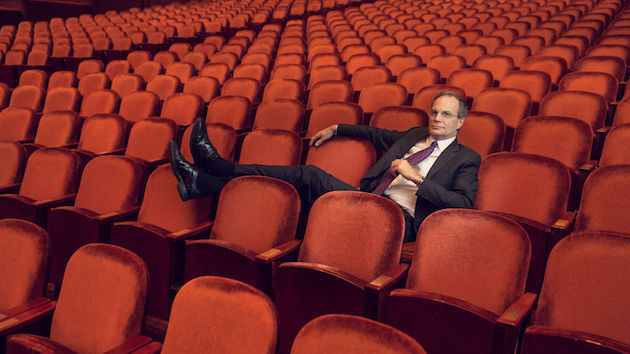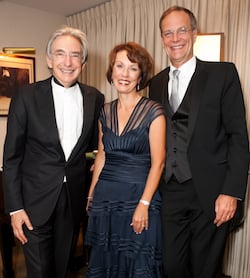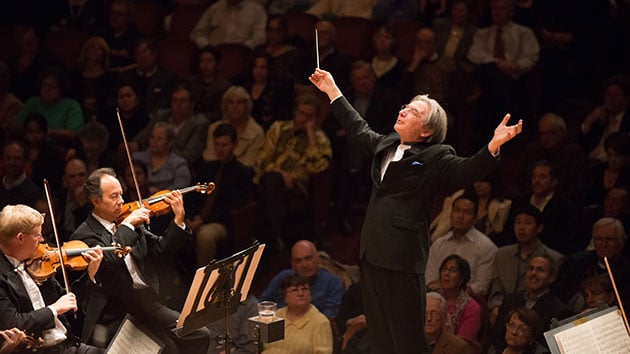
Brent Assink, a lanky man noted for precision, was cleaning out his office in Davies Symphony Hall the other day when we stopped by for a chat. After 18 years Assink has stepped away from his position as the executive director of the San Francisco Symphony (SFS). He was just the fourth executive of the symphony since 1939 and told us, “the legacy I’d like to be most recognized for is that the orchestra grew artistically during my tenure and that we sought to share that growth most broadly through media projects, varied types of concert formats, and expanded education programs.”
He was referring to endeavors such as American Mavericks, Keeping Score, and the Mahler recording cycle. Not to mention SoundBox, the symphony’s three-year-old very successful — and very expensive — attempt to use the informality of the club scene to create a new portal to experience classical music.
From a business perspective, despite persistent budget deficits and the 2013 labor strike, Mr. Assink’s symphony has been doing well, running along on a $75 million annual budget, along with a five-year $100 million capital campaign that brought in $140 million. But the audience is clearly changing, which is partly a reflection of San Francisco’s Silicon valley-tuned demographics and partly the evolution of a traditional audience.
The absolute number of total attendance at the symphony has dropped about 10 percent during Assink’s tenure. In effect, more individuals are coming, but less often. The good news is that the average age is dropping. What’s also changed are donor profiles and giving patterns, particularly in the last two years. The amount per donor has increased slightly and there is a new culture among donors, which is increasingly tied to Silicon Valley — as Assink put it, “with everything that that means.”
“We feel we’re running further to meet the expectations of both the audience and the donor community. What we’re seeing from the philanthropic community is often an expectation of instant results. And there is a cause and effect, by the way, less a sense of philanthropy just for philanthropy’s sake. The old reward was to watch the orchestra on the stage and that was enough. Now, it’s much more: ‘we love what you’re doing, keep on doing that, but we’d like to make sure that our philanthropy is enabling you to do (fill in the blank) and we want to see that soon, with measurable results.’”

Symphony as Civic Good
Such is the art of being an arts executive these days. It’s the managing of increasingly complex, even contradictory expectations, among all concerned. And, one might add, managing contradictory images. In San Francisco, for example, the Symphony’s place seems to have become less that of a cultural institution than a “social good.”
Said Assink, “An increasing number of people see the symphony as a ‘civic good’ contributing to the civic profile of the city. We could just as well be a park.”
One of Assink’s preoccupations has been to shape the symphony into common ground for the city’s various communities and constituencies. To that end, the symphony has become remarkably successful at building bridges to both the Asian and Hispanic communities: The Lunar New Year concert and the Day of the Dead concert have become wildly popular.
“If we’re going to matter to a lot of people,” said Assink, “we have to break down community barriers to classical music.”
However, one community that has been out of reach is the African-American community. Assink explains it this way, “we don’t have the resources or the energy, or whatever it is, to slot ourselves into a logical relationship with the African-American community, a relationship built on the kind of cultural tradition we have in other communities. If you don’t have that connection, the effort feels forced; it feels artificial, and then, I think, you’re worse off than if you didn’t do anything at all.”
If we’re going to matter to a lot of people, we have to break down community barriers to classical music.The symphony’s reaction has been to work ever more intensely with every elementary school in the San Francisco School district, through the Adventures in Music program, and reach out not only to children but to their parents. The hope is that parents can experience the music first-hand and reinforce the idea of an opportunity for their children.
But, of course, the problem is that because music classes have been dropped there’s less context for music written hundreds of years ago and played by people who dress oddly. And with attention spans shrinking the symphony would seem on the defensive. That, however, should not be a strategy according to Assink.
“So we have to educate but we don’t have to educate apologetically. We don’t have to say, ‘you know you might give this a try; you might like it.’ Instead, we need to say to them, ‘look at this music that’s been around for hundreds of years; it’s showing no signs of losing its appeal, more people are coming to listen to the San Francisco Symphony than ever before. So what’s going on with this? You can enhance your experience by learning more about it and we can educate you if you like, but that’s not required; all that’s required is that you try it. And then try it again. And again. Just give yourself more than one time.”
A Backstage Mistake
Looking back at his role as director Assink sees himself as neither the benevolent dictator nor a traditional consensus builder: “Building a consensus insures you’ll never get much beyond a level of mediocrity. My sense has been to go beyond what feels comfortable, and of course in the end we do get to consensus, but we work at reaching a higher level of consensus.”
As for the notion of dictator, he would put it another way: “I think the sense was there are certain lines beyond which Brent will not go, and we all need to remain focused on artistic excellence. Period. End of story.”

Naturally, in 20 years, there are decisions he would take back, notably one that began with an effort to improve backstage facilities for musicians, something wanting for a long time. But what began as a modest effort to redesign a relatively small space ballooned into something else altogether.
“We got too grand, too big, and I was part of that. It just got too expensive and collapsed under the weight of everything we were trying to do. We started by saying, ‘ok, we’re going to do that, but at the same time why don’t we also build educational spaces, and let’s build bigger lobbies for the audience, and let’s build underground parking.’ Maybe, what we should have said was, ‘let’s just improve the backstage space for musicians. Let’s start and stop there; let’s just see what that looks like.”
Assink notes that the reason the symphony didn’t take that path was in deference to the management doctrine that says, “incrementalism can be the death of organizations, so go big.” It’s long been an imperative for arts funders, whether individuals or institutions, to focus on something that’s big or getting bigger. Assink learned that lesson from the PBS series that featured Michael Tilson Thomas, which began with a local funder who saw the opportunity and asked for a proposal.
“So we sent a proposal — for one TV show. They called us up and said, ‘now, think bigger,’ which led to multiple years on PBS and nine DVDs.” People become very attached to legacy programs and they become part of the brand of an organization. But they may not be serving the same purpose they once did. That’s the kind of question we need to be asking.
The path between incrementalism and too grand is deciding what’s within the overall context of the organization, which in turn should reflect the mission statement and operational plan. “Context is key,” said Assink, who has become adverse to “mission creep where you kind of get pulled off the path by the look of that shiny object over there.”
The same is true with audience building.
“Building a future audience is not rocket science but what gets tricky is putting boundaries around what we should be doing. Education, for example. We do a lot of it and we love doing it, but the question has to be asked, especially with legacy programs that have been going on for a long time: why is the symphony doing this? Should somebody else be doing it? Can somebody else be doing it? People become very attached to legacy programs and they become part of the brand of an organization. But they may not be serving the same purpose they once did. That’s the kind of question we need to be asking.”
Survival of the Fittest?
Other questions to be asked include how to recast the role of a large symphony at a time when budget cuts threaten the National Endowment for the Arts and immigration bans may undermine the lives of some musicians. Some might argue that symphonies like SFS shouldn’t receive NEA money at all; that the large symphonies should prove their mettle without federal help. Brent Assink shakes his head at the thought.
“NEA money that comes to us goes to commissioning, to support our youth orchestra, for example, and for very special projects. It does not go into the kitty. But the logic escapes me — ‘The smaller you are, the more you merit the money and the less you need to stand on your own two feet?’ For any ticket buyer who comes in our door, the amount of federal subsidy for their experience is .01 percent. So for an organization with a smaller budget it could be 25 percent, and that’s held up as the model? That is somehow more meritorious, more justifiable? I don’t understand it.”
The smaller organizations are vitally important to a thriving symphony. And the fact is they can’t thrive if the symphony doesn’t thrive.Assink argues that a large symphony is a far more effective catalyst in fostering a healthy orchestra ecosystem than the government. Think of it this way, he said in so many words, one of our bassoon players is the conductor of a small amateur orchestra. We pay his salary — not for that — but the money allows him to play that additional role. Multiply that by 108 musicians earning full-time salaries, which enable them to lead an orchestra or teach classes or enrich this community in many different ways.
“We’ve always said the entire ecosystem is one. We are not the ones trying to drive wedges between big and small organizations. It’s just so easy for those outside this ecosystem to say, ‘you big guys are taking too much of the resources,’ as though it’s a zero-sum game. But it isn’t. The smaller organizations are vitally important to a thriving symphony. And the fact is they can’t thrive if the symphony doesn’t thrive.”
On the question of whether symphonies should become more politically visible, Assink doesn’t subscribe to the notion that classical music, by its nature, is apolitical. “Think of Beethoven. Even Bach, who got fired and put in jail because he was pushing against the strictures of the church composers. I acknowledge there’s a difference between those composers and those of us engaged in recreating what they wrote. I get that. Still, our audiences come in carrying with them a sense of what’s going on in the world politically. So the question for us is how to face people who may be upset at something Trump said or the immigration ban or whatever it is. Then what is our role? And who decides that?”
Assink acknowledged that SFS might consider a free immigration concert, such as the one held by the Seattle Symphony. But he remains convinced that at the end of the day you have to let the music be a unifying experience and you must always remember that the symphony’s charter is really to play Mozart as well as possible. “Because that’s what we do and to pretend we’re something else doesn’t sit right with me. Of course, we change with the times, but we can’t be an orchestra pulled in the latest protest direction. At our core, we’re responsible to this repertoire and that’s what people expect from us. That’s the message that always comes across, whether people can quite express it or not, ‘please don’t become something other than what you are because we need you as you are.’”
For Assink this is an important clue to realizing the future of the symphony, which incidentally he believes will be less tied to grand halls and trappings, and more to smaller spaces and advanced sound systems. Indeed, the future for executive directors will be not only the art of managing expectations but defining one’s organization. “I don’t know if I would say ‘survival of the fittest,' but more the ability to identify a niche.”
And finally, there is the art of anticipating the audience, itself. “If I’ve learned anything in the last 18 years it’s never to underestimate the wisdom of the audience.”

Intimations of a Symphony
Assink is 61, from Bellingham, Washington, originally. He went to college in Iowa and took an MA in Musicology from the University of Minnesota. He has the heartland look and heartland demeanor of Bill Moyers. He’s a pianist by training and also an organist at the First Presbyterian Church of Berkeley. He’s married and has three grown children.
Asked about life after Davies Hall, he will only say that his next act will take him away from the Bay Area and “on a new adventure out of the arts.” His regular seat in the hall, in row B, Loge A will go to his successor who has yet to be found. Derek Dean, the interim executive director, has been the symphony’s CEO for the last two years and a member of the board of governors since 2011.
And what does Mr. Assink take away from his 20 years? The music, itself, above all.
A few years ago, one of Mr. Assink’s daughters, then a senior in college, was diagnosed with a serious illness. Eventually, she reclaimed her health, but for three years the news from doctors was ever more dire. It was during this period, at a particularly dark moment, and during a symphony tour to Europe, that Assink had a revelation, although he couldn’t possibly describe its meaning.
“We were in Paris,” he recalled. “MTT was doing Mahler’s Ninth. I’ve heard that countless times in my life, and actually I think this was the fourth time on the tour, but for some reason on that particular night it tore me to shreds, from beginning to end. It was cathartic, disturbing, heartrending, transfixing, and completely unexpected. It took me on a journey that I didn’t know I needed to be on, but then realized I was glad I was on it.”
After the concert a friend sitting with Assink said, “Wow, are you ok?”
“Better now,” Assink replied, although he couldn’t say how.
“The point is,” he told us, “you realize that every night in the hall there is somebody having that kind of experience and sometimes perhaps a majority of people are having it; leaning forward in their seats, trying to catch every note, and perhaps reliving some great trauma. Trying to understand something. And somehow that helps. When you talk about the meaning of this kind of music, that’s what comes to mind. But what does it ‘mean’? How exactly is it transformational? To be honest, I’m a little nervous about dissecting it too much. All I know is that it works; there are no words.”
The San Francisco Conservatory of Music (SFCM) will honor Brent Assink at its Spring 2017 Gala, on Tuesday, April 18. Performers include soprano Deborah Voigt, pianist Jon Nakamatsu, and a brass quintet composed of conservatory faculty and students and members of the San Francisco Symphony. Gala proceeds go to collegiate and precollege scholarships, as well as community programs that provide music education to thousands of local young people. Gala tickets range from $1,500 to $10,000 per person. For more information go to the 2017 Gala website.
ADDENDUM: Brent Assink contacted us with the following statement, responding to the comments below:
"I would like to take this opportunity to address the dialogue surrounding my recently printed comments. First, I deeply apologize that I unintentionally gave the perception that the Symphony is not energetically pursuing every angle possible to serve all areas of our community, including the African-American community. When I said we didn't have the energy or resources to pursue a relationship, I was specifically referring to a long-held, but deferred, personal dream that our music education programs might expand even further throughout the Bay Area. I was certainly not making a comment about what the Symphony IS doing. My remark was, in fact, indicative of how widespread the need and the opportunities are.
And what the Symphony is doing currently sets this orchestra apart from almost all of its peers. It brings music and musicians into schools, into community centers, into hospitals. We focus most of our efforts on young people and most specifically the diverse student body in the San Francisco Unified School District. So I ask that my comments be taken as an expression that, while the Symphony is doing a great deal, there is still so much more to be done."

